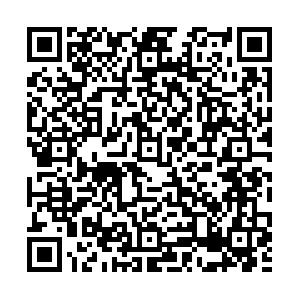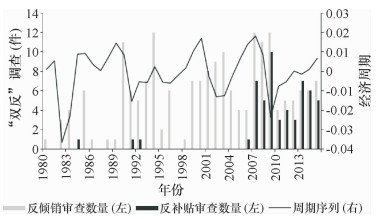Business Cycle, Market Power and Trade Barriers Against China
-
摘要: 近年来, 世界经济形势不确定性增加, 贸易壁垒在全球范围内显著加剧。基于HS6分位行业的面板数据, 分析1988—2018年各国对华贸易壁垒的周期性及市场势力对贸易壁垒的影响, 发现各国对华关税壁垒与非关税壁垒具有不同特点, 其中关税壁垒呈现出显著的顺周期性, 非关税壁垒则不具有显著的周期性。分组回归发现, 在经济繁荣时期, 低收入国家容易提高对华关税水平, 高收入国家容易增加对华非关税壁垒; 在经济运行不佳时期, 各国均倾向增加对华反补贴审查频次。进一步分析还发现, 高市场势力容易导致对华非关税壁垒多发, 继而还会在经济繁荣期推动对华关税上升。这一研究为理解贸易壁垒的周期性提供了新的视角, 对逆全球化背景下中国的经贸政策制定具有一定启示。Abstract: In recent years, there are increasing uncertainties in the world economy, and significantly increasing trade barriers worldwide. Based on the panel data of disaggregated product level(HS6) between1988 and 2018, this paper analyzes the impact of business cycle and market power on trade barriers against China. It is found that tariff and non-tariff barriers have different characteristics, among which tariff barriers show significant pro-cyclicality, while non-tariff barriers do not. Group regressions show that in the period of economic prosperity, low-income countries tend to raise tariffs level on China, while high-income countries tend to increase non-tariff barriers against China; in the period of economic downturn, all countries tend to increase the probability of countervailing barriers against China. In addition, the findings indicate that market power enhances the non-tariff barriers and drives the pro-cyclicality of tariffs. This study puts forward a new perspective to understand the cyclicity of trade barriers, which presents some enlightenment to China's trade policy-making under the background of deglobalization.
-
Key words:
- trade with China /
- business cycle /
- deglobalization /
- market power /
- trade barriers /
- tariff barriers /
- non-tariff barriers
-
图 1 1980—2015年美国对华反倾销、反补贴审查数量与美国经济周期变化情况
注: 图中数据根据世界银行反倾销数据库及世界银行发展指标数据库相关数据整理得到。其中,经济周期序列为美国实际GDP的自然对数经过HP滤波得到的周期成分。图 2同。
表 1 主要变量的描述性统计特征
变量 观测值个数 均值 标准差 最小值 最大值 tariff 3 695 540 9.036 7 9.498 2 0 50 BC 3 693 151 0.000 2 0.017 1 -0.176 0 0.199 1 trend 3 693 151 25.859 0 2.120 4 20.536 8 30.511 0 mp 1 748 023 -1.999 0 1.983 3 -6.907 7 6.840 8 wto 3 695 540 0.932 7 0.250 6 0 1 im 2 693 228 0.107 9 0.207 2 0 1 wto_im 2 693 228 0.097 0 0.198 4 0 1 ttbd 956 429 0.001 3 0.036 5 0 1 表 2 关税壁垒估计结果
变量 (1) (2) (3) BC 1.631 6***(0.174 4) 1.755 9***(0.260 8) 0.725 5***(0.267 5) trend -5.963 9***(0.029 2) -7.236 5***(0.043 7) -6.909 7***(0.044 2) mp -0.001 4(0.002 3) -0.001 4(0.002 3) im -0.272 8***(0.091 9) wto -1.592 0***(0.035 9) wto_im 0.713 9***(0.091 2) 常数项 163.046 7***(0.7558) 201.385 8***(1.1677) 194.420 0***(1.181 7) 时间效应 控制 控制 控制 国家×行业效应 控制 控制 控制 R2 0.771 5 0.778 7 0.780 2 样本量 3 691 587 1 747 060 1 680 763 注:*、**和***分别代表在10%、5%和1%水平上显著;括号内为稳健标准误。下表同。 表 3 非关税壁垒估计结果
变量 (1) (2) (3) BC 0.001 9(0.002 2) 0.001 9(0.002 2) 0.003 0(0.002 5) trend -0.001 1**(0.000 5) -0.001 1**(0.000 5) -0.001 2**(0.000 5) mp 0.000 0*(0.000 0) 0.000 1**(0.000 0) im 0.003 2***(0.000 8) wto (D) wto_im -0.001 9***(0.000 7) 常数项 0.035 9**(0.014 5) 0.036 0**(0.014 5) 0.038 2**(0.015 7) 时间效应 控制 控制 控制 国家×行业效应 控制 控制 控制 R2 0.038 3 0.038 3 0.0374 样本量 955 932 955 932 802463 注:因wto变量与因变量均为虚拟变量,控制多维固定效应的情况下,由于共线性的存在,所以估计结果中wto变量被忽略。 表 4 贸易壁垒与经济周期的PPML和Logit估计结果
变量 (1) (2) (3) (4) (5) (6) tariff tariff tariff ttbd ttbd ttbd BC 0.158 0***
(0.031 5)0.237 3***
(0.043 2)0.180 8***
(0.044 4)1.082 9
(2.082 7)1.127 0
(2.101 1)2.0245
(2.2400)trend -0.475 8***
(0.016 1)-0.600 1***
(0.024 4)-0.569 0***
(0.025 0)-0.021 2
(0.017 8)-0.024 6
(0.017 8)-0.0599***
(0.0187)mp -0.000 2
(0.000 6)-0.000 3
(0.000 6)0.099 0***
(0.017 3)0.1220***
(0.0189)im -0.193 5***
(0.020 4)1.8158***
(0.5964)wto -0.307 9***
(0.011 1)0.1207
(0.5230)wto_im 0.270 6***
(0.021 0)-1.0685*
(0.6059)常数项 - - - -8.038 6***
(0.554 2)-7.731 8***
(0.556 8)-6.861 1***
(0.765 9)时间效应 控制 控制 控制 控制 控制 控制 国家×行业效应 控制 控制 控制 控制 控制 控制 R2 0.037 1 0.038 7 0.042 4 0.000 1 0.000 2 0.000 3 样本量 3 338 758 1 574 721 1 511 736 948 355 948 255 794 866 表 5 基于BK滤波方法计算经济周期的检验结果
变量 (1) (2) (3) (4) tariff tariff ttbd ttbd BC 8.600 8***(0.184 1) 5.735 9***(0.271 1) 0.002 9(0.002 2) 0.002 9(0.002 2) trend -7.282 5***(0.035 0) -7.937 4***(0.049 6) -0.001 3***(0.000 5) -0.001 3***(0.000 5) mp -0.001 9(0.002 4) 0.000 0*(0.000 0) 常数项 197.036 3***(0.902 4) 219.946 9***(1.323 2) 0.039 6***(0.014 7) 0.039 7***(0.014 7) 时间效应 控制 控制 控制 控制 国家×行业效应 控制 控制 控制 控制 R2 0.772 6 0.778 9 0.039 1 0.039 1 样本量 3 385 216 1 614 724 946 804 946 804 表 6 关税壁垒的异质性检验结果
变量 (1) (2) (3) 低收入国家 高收入国家 美国 BC 12.611 1***(0.430 4) 0.122 9(0.266 8) -5.053 6***(0.761 9) trend -13.870 0***(0.089 4) -1.560 3***(0.033 3) -3.855 2***(0.042 7) mp -0.002 4(0.003 9) -0.000 4(0.002 3) 常数项 375.827 3***(2.358 6) 47.972 7***(0.901 7) 120.455 8***(1.290 9) 时间效应 控制 控制 未控制 国家×行业效应 控制 控制 控制 R2 0.757 2 0.823 4 0.779 2 样本量 837 166 777 558 98 188 注:第(3)列的国家×行业效应实际控制的是HS4分位的行业效应,因市场势力随国别行业变动,所以未控制市场势力。 表 7 非关税壁垒的异质性检验结果
变量 (1) (2) (3) (4) (5) 低收入国家 高收入国家 美国 gad gcvd BC -0.000 8(0.002 9) 0.008 9**(0.003 7) 0.056 7**(0.022 4) 0.002 2(0.002 2) -0.000 8**(0.000 4) trend -0.001 6(0.001 1) -0.000 7*(0.000 4) 0.005 6***(0.001 4) -0.000 7(0.000 5) -0.001 6***(0.000 2) mp 0.000 0(0.000 0) 0.000 1**(0.000 0) 0.000 0(0.000 0) 0.000 0**(0.000 0) 常数项 0.049 9(0.032 4) 0.022 4**(0.011 1) -0.166 2***(0.042 4) 0.022 4(0.014 2) 0.048 5***(0.005 0) 时间效应 控制 控制 未控制 控制 控制 国家×行业效应 控制 控制 控制 控制 控制 R2 0.045 9 0.026 8 0.055 4 0.037 3 0.028 4 样本量 484 396 471 536 69 948 955 932 955 932 注:第(3)列控制了行业效应,因市场势力随行业变动,所以未控制市场势力变量。 表 8 经济周期影响贸易壁垒的机制检验结果
变量 (1) (2) (3) (4) (5) (6) tariff tariff tariff ttbd ttbd ttbd BC 2.405 7***
(0.302 4)2.403 1***
(0.302 4)1.208 7***
(0.309 6)0.001 4
(0.002 5)0.001 4
(0.002 5)0.002 4
(0.002 8)trend -7.756 6***
(0.048 7)-7.756 6***
(0.048 7)-7.338 4***
(0.049 2)-0.001 1**
(0.000 5)-0.001 1**
(0.000 5)-0.001 2**
(0.000 5)BC×mp_hi 2.045 8***
(0.443 5)2.053 1***
(0.443 7)2.442 2***
(0.447 6)0.001 9
(0.004 4)0.001 8
(0.004 4)0.002 3
(0.005 0)mp -0.0021
(0.002 3)-0.002 1
(0.002 4)0.000 0*
(0.000 0)0.000 1**
(0.000 0)im -0.269 9***
(0.091 5)0.003 2***
(0.000 8)wto -1.596 9***
(0.035 8)(D) wto_im 0.732 0***
(0.090 8)-0.001 9***
(0.000 7)常数项 215.130 8***
(1.300 0)215.126 6***
(1.300 0)250.763 1***
(1.315 6)0.035 9**
(0.014 5)0.036 0**
(0.014 5)0.038 3**
(0.015 7)时间效应 控制 控制 控制 控制 控制 控制 国家×行业效应 控制 控制 控制 控制 控制 控制 R2 0.778 7 0.778 7 0.779 9 0.038 3 0.038 3 0.037 4 样本量 1 614 724 1 614 724 1 552 966 955 932 955 932 802 463 -
[1] 郑宝银, 林发勤. 世界经济周期对我国出口贸易的影响[J]. 国际贸易问题, 2009(1): 3-9. https://www.cnki.com.cn/Article/CJFDTOTAL-GJMW200901002.htm [2] 郎丽华, 张连城. 中国经济周期与对外贸易周期的关系研究[J]. 经济学动态, 2011(11): 24-30. https://www.cnki.com.cn/Article/CJFDTOTAL-JJXD201111007.htm [3] BOWN C P, CROWLEY M A. Emerging economies, trade policy, and macroeconomic shocks[J]. Journal of Development Economics, 2014, 111(C): 261-273. http://www.sciencedirect.com/science/article/pii/S0304387814000522 [4] 梁碧波. 经济周期、政治周期与美国对华贸易政策[J]. 学术研究, 2007(10): 77-81. doi: 10.3969/j.issn.1000-7326.2007.10.014 [5] 贾玉成, 翟中玉. 经济政策不确定性、国家形象与制度环境差异——对华贸易摩擦的理论解析与实证检验[J]. 广东财经大学学报, 2019(4): 4-17. https://www.cnki.com.cn/Article/CJFDTOTAL-SONG201904001.htm [6] LAKE J, LINASK M K. Could tariffs be pro-cyclical?[J]. Journal of International Economics, 2016, 103(C): 124-146. http://smartsearch.nstl.gov.cn/paper_detail.html?id=37371dbb3d770a607538aa9153cf5c3f [7] GAWANDE K, HOEKMAN B, CUI Y. Global supply chains andtrade policy responses to the 2008 financial crisis[J]. World Bank Economic Review, 2015, 29(1): 102-128. doi: 10.1093/wber/lht040 [8] ROSE A K. The march of an economic idea? protectionism isn't counter-cyclic(anymore)[J]. Economic Policy, 2013, 28(76): 569-612. doi: 10.1111/1468-0327.12017 [9] GOLDBERG P K, PAVCNIK N. The effects of trade policy[R]. Cambridge: NBER Working Paper, No. 21957, 2016. [10] BOWN C P, CROWLEY M A. Import protection, business cycles, and exchange rates: evidence from the great recession[J]. Journal of International Economics, 2013, 90(1): 50-64. doi: 10.1016/j.jinteco.2012.12.001 [11] OATLEY T. A political economy of American hegemony: buildups, booms and busts[M]. New York: Cambridge University Press, 2015: 1-10. [12] KNETTER M M, PRUSA T J. Macroeconomic factors and antidumping flings: evidence from four countries[J]. Journal of International Economics, 2003, 61(1): 1-17. doi: 10.1016/S0022-1996(02)00080-6 [13] AGGARWAL A. Macro economic determinants of antidumping: a comparative analysis of developed and developing countries[J]. World Development, 2004, 32(6): 1043-1057. doi: 10.1016/j.worlddev.2004.01.003 [14] 欧阳日辉, 孙宝惠, 蒋旭东. 美国贸易保护的政治经济周期实证分析[J]. 北京工商大学学报: 社会科学版, 2010(9): 21-26. https://www.cnki.com.cn/Article/CJFDTOTAL-BJSB201005007.htm [15] 渠慎宁, 杨丹辉. 贸易保护的周期性变化——美国的经验分析及金融危机的影响[J]. 世界经济研究, 2009(10): 39-44, 88. https://www.cnki.com.cn/Article/CJFDTOTAL-JING200910011.htm [16] GRUNDKE R, MOSER C. Hidden protectionism? evidence from non-tariff barriers to trade in the United States[J]. Journal of International Economics, 2019, 117(C): 143-157. [17] 王晰. 农业TTB与宏观经济因素[J]. 财经科学, 2014(11): 72-82. doi: 10.3969/j.issn.1000-8306.2014.11.008 [18] KEE H L, NEAGU C, NICITA A. Is protectionism on the rise? assessing national trade policies during the crisis of 2008[J]. The Review of Economics and Statistics, 2013, 95(1): 342-346. doi: 10.1162/REST_a_00241 [19] 徐芳燕, 陈劭潼. 印度对中国反倾销行为的驱动因素分析[J]. 国际经贸探索, 2017(10): 66-79. https://www.cnki.com.cn/Article/CJFDTOTAL-GJTS201710005.htm [20] LUDEMA R D, MAYDA A M. Do terms-of-trade effects matter for trade agreements? theory and evidence from WTO countries[J]. The Quarterly Journal of Economics, 2013, 128(4): 1837-1893. doi: 10.1093/qje/qjt016 [21] NICITA A, OLARREAGA M, SILVA P. Cooperation in WTO's tariff waters[J]. Journal of Political Economy, 2018, 126(3): 1302-1338. doi: 10.1086/697085 [22] BESHKAR M, BOND E W, RHO Y. Tariff binding and overhang: theory and evidence[J]. Journal of International Economics, 2015, 97(1): 1-13. doi: 10.1016/j.jinteco.2015.04.004 [23] BRODA C, LIMAO N, WEINSTEIN D E. Optimal tariffs and market power: the evidence[J]. The American Economic Review, 2008, 98(5): 2032-2065. doi: 10.1257/aer.98.5.2032 [24] BAGWELL K, STAIGER R W. What do trade negotiators negotiate about? empirical evidence from the World Trade Organization[J]. The American Economic Review, 2011, 101(4): 1238-1273. doi: 10.1257/aer.101.4.1238 [25] TREFLER D. Trade liberalization and the theory of endogenous protection: an econometric study of U. S. import policy[J]. Journal of Political Economy, 1993, 101(1): 138-160. doi: 10.1086/261869 [26] BAGWELL K, STAIGER R W. Protection and the business cycle[J]. Advances in Economic Analysis and Policy, 2003, 3(1): 1139. http://www.sciencedirect.com/science/article/pii/B978012781820750008X [27] BOWN C P, TOVAR P. Preferential liberalization, antidumping, and safeguards: stumbling block evidence from MERCOSUR[J]. Economics and Politics, 2016, 28(3): 262-294. doi: 10.1111/ecpo.12083 [28] 刘悦, 刘建江. 市场化程度是否提升了对中国企业市场经济地位的认可——基于欧盟对华反倾销的调查事实[J]. 国际贸易问题, 2019(6): 65-84. https://www.cnki.com.cn/Article/CJFDTOTAL-GJMW201906005.htm [29] 杨飞, 孙文远, 程瑶. 技术赶超是否引发中美贸易摩擦[J]. 中国工业经济, 2018(10): 99-117. https://www.cnki.com.cn/Article/CJFDTOTAL-GGYY201810007.htm [30] BOWN C P. Temporary trade barriers database[R/OL]. 2010-06-10[2019-08-20]. http://econ.worldbank.org/ttbd. [31] RAVN M O, UHLIG H. On adjusting the hodrick-prescott filter for the frequency of observations[J]. Review of Economics and Statistics, 2002, 84(1): 371-380. http://www.emeraldinsight.com/servlet/linkout?suffix=b74&dbid=16&doi=10.1108%2F09596111111153501&key=10.1162%2F003465302317411604 [32] 钱学锋, 龚联梅. 市场经济地位真的那么重要吗?——来自21个经济体对中国反倾销的证据[J]. 产业经济评论, 2017(3): 15-33. doi: 10.3969/j.issn.2095-5073.2017.03.002 -





 下载:
下载:


